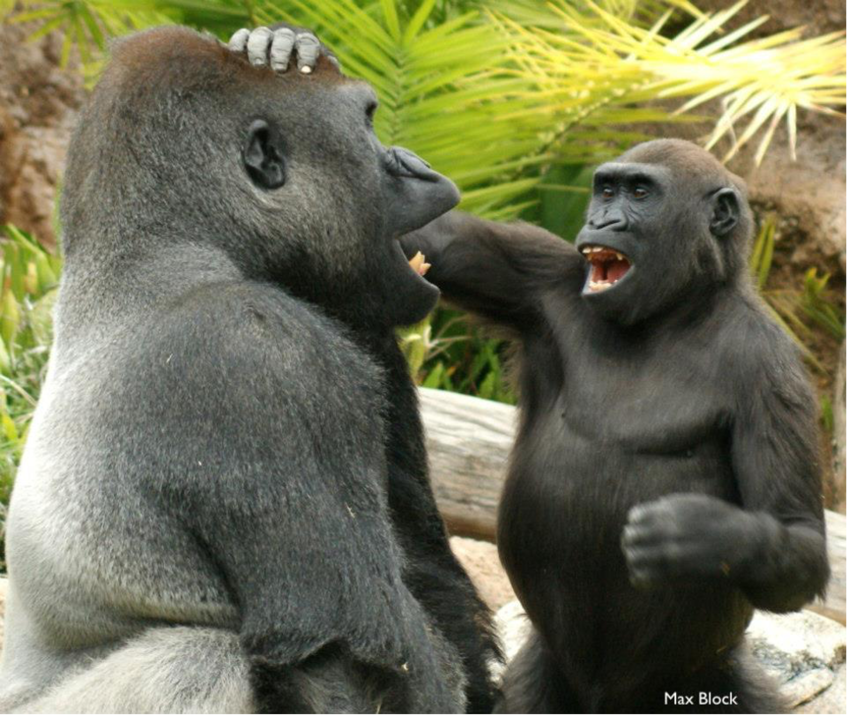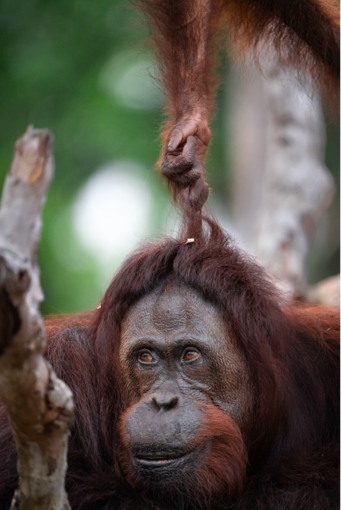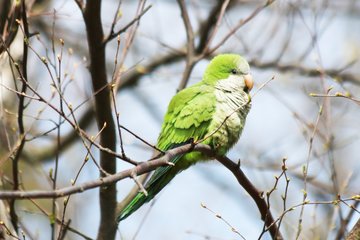Do apes have humor?
Great apes playfully tease each other
Babies playfully tease others as young as eight months of age. Since language is not required for this behavior, similar kinds of playful teasing might be present in non-human animals. Now cognitive biologists and primatologists from the University of California Los Angeles, the Max Planck Institute of Animal Behavior (Germany), Indiana University, and the University of California San Diego have documented playful teasing in four species of great apes. Like joking behavior in humans, ape teasing is provocative, persistent, and includes elements of surprise and play. Because all four great ape species used playful teasing, it is likely that the prerequisites for humor evolved in the human lineage at least 13 million years ago.

Joking is an important part of human interaction that draws on social intelligence, an ability to anticipate future actions, and an ability to recognize and appreciate the violation of others’ expectations. Teasing has much in common with joking, and playful teasing may be seen as a cognitive precursor to joking. The first forms of playful teasing in humans emerge even before babies say their first words, as early as eight months of age. The earliest forms of teasing are repetitive provocations often involving surprise. Infants tease their parents by playfully offering and withdrawing objects, violating social rules (so-called provocative non-compliance), and disrupting others’ activities.
In a study, scientists from the University of California Los Angeles, the Max Planck Institute of Animal Behavior, Indiana University, and the University of California San Diego (Isabelle Laumer, Sasha Winkler, Federico Rossano, and Erica Cartmill, respectively) report evidence of playful teasing in the four great ape species: orangutans, chimpanzees, bonobos and gorillas. “Great apes are excellent candidates for playful teasing, as they are closely related to us, engage in social play, show laughter and display relatively sophisticated understandings of others’ expectations,” says Isabelle Laumer, a post-doctoral researcher at the University of California Los Angeles and the Max Planck Institute of Animal Behavior.
The team analyzed spontaneous social interactions that appeared to be playful, mildly harassing, or provocative. During these interactions, the researchers observed the teaser’s actions, bodily movements, facial expressions, and how the targets of the teasing responded in turn. They also assessed the teaser’s intentionality by looking for evidence that the behavior was directed at a specific target, that it persisted or intensified, and that teasers waited for a response from the target.
Teasing to provoke a response

The researchers found that orangutans, chimpanzees, bonobos and gorillas all engaged in intentionally provocative behavior, frequently accompanied by characteristics of play. They identified 18 distinct teasing behaviors. Many of these behaviors appeared to be used to provoke a response, or at least to attract the target’s attention. “It was common for teasers to repeatedly wave or swing a body part or object in the middle of the target’s field of vision, hit or poke them, stare closely at their face, disrupt their movements, pull on their hair or perform other behaviors that were extremely difficult for the target to ignore,” explains UCLA and IU professor Erica Cartmill, senior author of the study.
Although playful teasing took many forms, the authors note that it differed from play in several ways. “Playful teasing in great apes is one-sided, very much coming from the teaser often throughout the entire interaction and rarely reciprocated,” explains Cartmill. “The animals also rarely use play signals like the primate ‘playface’, which is similar to what we would call a smile, or ‘hold’ gestures that signal their intent to play.”
Similarity with human behavior
Playful teasing mainly occurred when apes were relaxed, and shared similarities with behaviors in humans. “Similar to teasing in children, ape playful teasing involves one-sided provocation, response waiting in which the teaser looks towards the target’s face directly after a teasing action, repetition, and elements of surprise,” Laumer explains.
The researchers noted that Jane Goodall and other field primatologists had mentioned similar behaviors happening in chimpanzees many years ago, but this new study was the first to systematically study playful teasing. “From an evolutionary perspective, the presence of playful teasing in all four great apes and its similarities to playful teasing and joking in human infants suggests that playful teasing and its cognitive prerequisites may have been present in our last common ancestor, at least 13 million years ago,” explains Laumer. “We hope that our study will inspire other researchers to study playful teasing in more species in order to better understand the evolution of this multi-faceted behavior. We also hope that this study raises awareness of the similarities we share with our closest relatives and the importance of protecting these endangered animals.”














